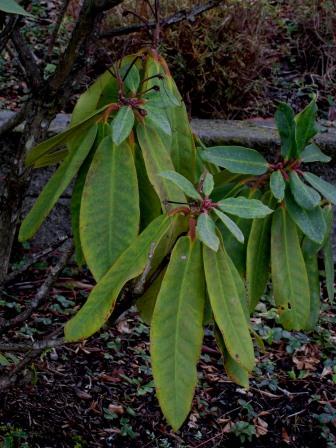Today we have a diagnosis question. Consider this unhappy rhododendron:

While there is more than one problem with this poor thing, the one I’d like you to think about is why the newer leaves are smaller than the old leaves. (They are fully mature.) There are two parts to this question:
1) What is the physiological reason that the leaves are smaller? (In other words, what is directly causing this difference?)
2) Knowing this, what does this tell you about the underlying problem? (This is related to diagnosing what’s happening in the landscape that you could actually see if you knew where to look.)
I hope that’s not too confusing! I’ll monitor the blog over the weekend and add clarification if I need to.
Answer on Monday!
My initial thought is that there is too much light. Maybe this went from being a shade garden to a more sunny one. The leaves are responding by reducing their size. Can’t wait to read the answer.
The leaves look chlorotic which makes me think the pH isn’t low enough. The stunted growth could be the result of standing water or too little water.
Hard to see the plant behind it, but it looks like it got hit with an herbicide. Collateral damage, perhaps?
Smaller leaves could indicate lack of nitrogen in the soil or root issues; root rot from too much water or too little air in the soil, roots got cut into for some reason, etc. But I’m sure there some trick just outside the picture frame.
Could the masonry wall in the background be interfering with pH, the roots, and/or water drainage (did the rhodie outgrow it’s spot)?
I’ll go with lack of nitrogen. Older leaves yellow as nitrogen is moved to new growth, and new growth is smaller because there’s still not enough N. As to the cause, I’ll guess poor drainage. It looks like the plant is below a retaining wall at the foot of a slope.
The usual cause for smaller leaves is exposure to more light than in the past. So our guess is that tall shrubs or trees were removed around this plant. This can also be seen from the new seedlings below it. It looks like this Rhodo is suffering from lack of drainage at the bottom of this retaining wall, and even more so now that competing plants are removed.